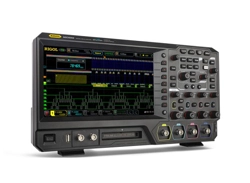Loading ...
Loading ...
Loading ...

RIGOL Chapter 17 Function/Arbitrary Waveform Generator (Option)
17-2 MSO5000 User Guide
To Output Basic Waveforms
Press GI on the front panel or enable the touch screen to tap the GI label at the
bottom of the screen to enable/disable the output of the [GI] connector on the front
panel, and enter the Function/Arbitrary Waveform Generator setting interface.
MSO5000 series' built-in Function/Arbitrary Waveform Generator can output a variety
of basic waveforms, including Sine, Square, Ramp, Pulse, DC, Noise, Sinc, Exp.Rise,
Exp.Fall, ECG, Gauss, Lorentz, Haversine, and Arb.
To Output Sine
Press Wave, rotate the multifunction knob to select "Sine". Press down the
knob to select it. You can also press Wave continuously or enable the touch screen
to select it. At this time, you can set the parameters for the sine waveform.
1. Set the frequency or period
First select Frequency or Period, then rotate the multifunction knob to
select "Frequency" or "Period". You can also press Frequency or Period
continuously to select it. Also, you can enable the touch screen to select it.
Rotate the multifunction knob
or use the pop-up numeric keypad to set the
frequency or period value of the current signal. Different waveforms have
different frequency or period (reciprocal of the frequency) ranges.
Sine: 100 mHz to 25 MHz
Square: 100 mHz to 15 MHz
Ramp: 100 mHz to 100 kHz
Pulse: 100 mHz to 1 MHz
DC and Noise: no frequency parameter.
2. Set the amplitude or high level
First select Amplitude or High Level, then rotate the multifunction knob to
select "Amplitude" or "High Level". You can also press Amplitude or High
Level continuously to select it. Also, you can enable the touch screen to select it.
Rotate the multifunction knob
or use the pop-up numeric keypad to set the
amplitude or high level value of the current signal. Note that if you select
"Amplitude" for this menu, then the menu below the Amplitude is automatically
turns out to be "Offset"; if you select "High Level" for this menu, then the menu
below the High Level is automatically turns out to be "Low Level". When
Impedance is set to "HighZ", the available range is from 20 mVpp to 5 Vpp; when
Impedance is set to "50Ω", the available range is from 10 mVpp to 2.5 Vpp.
3. Set the offset or low level
First select Offset or Low Level, then rotate the multifunction knob to
select "Offset" or "Low Level". You can also press Offset or Low Level
Loading ...
Loading ...
Loading ...
